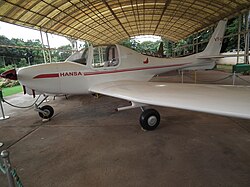NAL Hansa
| NAL Hansa | |
|---|---|

|
|
| Type: | Trainer aircraft |
| Design country: | |
| Manufacturer: | |
| First flight: |
November 23, 1993 |
| Commissioning: |
1999 |
The NAL Hansa ( Sanskrit : हंस (swan) ) is a trainer aircraft from the Indian manufacturer Taneja Aerospace and Aviation Ltd (TAAL).
History and construction
The Hansa was developed by the Indian National Aerospace Laboratories as the successor to the training aircraft used by the Indian flying clubs . The machine is made almost entirely of composite materials. The aircraft is designed as a low-wing aircraft with a non-retractable nose wheel landing gear. The two pilots sit next to each other in the cockpit.
Versions
- Hansa-2 : prototype
- Hansa-2RE : Name of the prototype after a new engine was installed, the wingspan was enlarged and the airframe, especially in the cockpit area, was revised. First flight on January 26, 1996
- Hansa-3 : Production version of the 2RE.
- Hansa-S : Originally called Hansa-4, it is the series version equipped with a Safran SR305-230E diesel engine with 230 HP.
- Hansa UAV : Unmanned Drone
Technical specifications
| Parameter | Data |
|---|---|
| crew | 2 |
| length | 7.66 m |
| span | 10.47 m |
| height | 2.61 m |
| Wing area | 12.47 m² |
| Empty mass | 545 kg |
| Max. Takeoff mass | 750 kg |
| Cruising speed | 178 km / h |
| Top speed | 213 km / h |
| Service ceiling | ? m |
| Range | 842 km |
| Engines | 1 × Rotax 914 F3, 85 kW (113 PS) |
See also
literature
- Paul Jackson: Jane's All The World's Aircraft 2003-2004. P. 209, ISBN 0-7106-2537-5 .
Web links
Commons : NAL Hansa - collection of images, videos and audio files
- Data sheet on the manufacturer's website , accessed on March 25, 2016
Individual evidence
- ↑ http://www.nal.res.in/oldhome/pages/ipmay99.htm
- ↑ Official website of the engine manufacturer - SMAengines
- ↑ Data from Jane's All The World's Aircraft 2004–2005 , p. 210
